Possible Explanations for the Observed Rise in the Incidence of Lung Adenocarcinoma relative to that of Lung Squamous Cell Carcinoma
Peter N Lee
DOI10.21767/2572-309X.100014
Peter N Lee*
PN Lee Statistics and Computing Limited, 17 Cedar Road, Sutton, Surrey, SM1 5DA, United Kingdom
- *Corresponding Author:
- Peter N Lee
PN Lee Statistics and Computing Limited, 17 Cedar Road, Sutton, Surrey, SM1 5DA, United Kingdom.
Tel: +44(0)2086428265
Fax: +44(0)2086422135
E-mail: PeterLee@pnlee.co.uk
Received date: June 01, 2016; Accepted date: June 09, 2016; Published date: June 14, 2016
Citation: Lee PN. Possible Explanations for the Observed Rise in the Incidence of Lung Adenocarcinoma relative to that of Lung Squamous Cell Carcinoma. J.Adenocarcinoma. 2016, 1:2. doi: 10.21767/2572-309X.100014
Abstract
The observed rise in the incidence of lung adenocarcinoma relative to lung squamous cell carcinoma has been claimed to result from changes in cigarette design associated with the shift to lower tar filter cigarettes. We present evidence that tends to undermine this claim. In particular, a recently published review based on extensive data has shown that there has been a substantial rise in the relative frequency of adenocarcinoma compared to squamous cell carcinoma in those who have never smoked.
Keywords
Lung cancer; Histological type; Diagnosis; Smoking habit; Low tar cigarettes
In 2014, the US Surgeon General [1] noted that “the incidence of adenocarcinoma of the lung and the proportion of lung cancer that is adenocarcinoma has increased dramatically during the past several decades” and argued that this “results from changes in the design and consumption of cigarettes since the 1950s.” The argument that the switch to lower tar filtered cigarettes from the older, higher tar, plain cigarettes has been responsible for the rise in the incidence of adenocarcinoma (AdC) and in the ratio of AdC to squamous cell carcinoma (SqCC) is one that has been made previously on various occasions, [2-4] and has been supported by various researchers [5,6].
While an increase in the frequency of AdC relative to SqCC is clearly evident in many countries [7], a number of pieces of evidence suggest that changes in cigarette design do not explain the observed trends in the histological type of lung cancer.
One reason for doubting the claim lies in the observation by Chen et al. [8] that the observed increase in the frequency of AdC relative to SqCC began well before the increase in low tar filtered cigarette consumption started.
Another reason is that epidemiological studies show no overall evidence of any increase in the risk of AdC associated with filter vs. plain or lower vs. higher tar cigarettes [5,9-12]. Low tar filter cigarettes are associated with a small reduction in risk of SqCC, but not enough to explain the observed large rise over time in the frequency of AdC relative to SqCC.
Although the US Surgeon General [1] dismissed changes in diagnostic procedures as unimportant to their argument, there is in fact quite clear evidence that they are relevant. Firstly, there have been a number of changes in how certain tumour types are classified in successive published schemes for classifying histological type of lung cancer. Notably, one of the four classes of large cell carcinoma in the WHO 1967 classification [13] was reallocated to AdC in the WHO 1981 classification [14]. Second, large studies generally report a significant increase in numbers of AdC when diagnoses of histological type made some years earlier were reviewed by pathologists some years later using the latest classification schemes [15]. Third, studies using standard criteria to review cases collected over a period of at least 10 years generally (although there are exceptions) found no increase in the proportion of lung cancers classified as AdC [15,16]. Interestingly, one of those studies that did report a rise in AdC noted that this was due to the contribution of a substantial increase in the rate of bronchioloalveolar carcinoma, affecting smokers and nonsmokers alike, which the authors suggested may have a viral origin.
One of the weakest links in the Surgeon General’s argument [1] is that the shift from SqCC to AdC “is confined to smokers.” Though they claimed that “neither the overall risk of lung cancer nor the risk of adenocarcinoma has changed over time among never smokers”, there has in fact been a clear change in never smokers. That there has been such a change is supported by an analysis [17] in which absolute lung cancer mortality rates by smoking habit and histological type were estimated indirectly based on relative risk estimates from studies published in the 20th century, coupled with WHO mortality data for the same country and period. It is also supported by results reported by Samet et al. [18], who noted that in men the rate of AdC was increasing over time and the rate of SqCC was decreasing, regardless of smoking habits.
That a change in never smokers has occurred has recently been demonstrated even more clearly in a study published in Regulatory Toxicology and Pharmacology [15]. That study investigated how the proportion of AdC varied in never smokers by time, sex and region, based on published evidence from epidemiological studies on the distribution of lung cancer types. Data were analysed from 219 sex- and period- specific blocks of data drawn from 157 publications. It was clear that there was a time-related increase in the proportion of AdC which was evident in both sexes, all regions, and regardless of the denominator used (AdC and SqCC combined, the four main histological types combined, or all lung cancer cases). Compared to the period 1950-69, the ratio of AdC to SqCC was higher by a factor 1.67 in 1970-79, 1.97 in 1980-89, 2.35 in 1990-99 and 3.93 in 2000 onwards. The authors present arguments that the time trends could not be explained by limitations in the literature searches, changes in exposure to environmental tobacco smoke, or the inclusion of misclassified current or former smokers among the never smokers.
While the switch to lower tar filter cigarettes may somewhat have affected the relative frequency of AdC to SqCC the actual available epidemiological evidence suggests that this is because changes in cigarettes have reduced the risk of SqCC not because they have increased the risk of AdC. Also the evidence suggests that the differing trends in AdC and SqCC are due partly to changes in diagnosis and partly to other factors that affect nonsmokers and smokers alike. More research is certainly needed to clarify what these factors are.
References
- US Surgeon General (2014)The health consequences of smoking - 50 years of progress: a report of the Surgeon General. US Department of Health and Human Services, Centers for Disease Control and Prevention, National Center for Chronic Disease Prevention and Health Promotion, Office on Smoking and Health, Atlanta, Georgia, USA.
- Burns DM, Anderson CM, Gray N (2011) Do changes in cigarette design influence the rise in adenocarcinoma of the lung? Cancer Causes Control 22: 13-22.
- Thun MJ, Burns DM (2001) Health impact of "reduced yield" cigarettes: a critical assessment of the epidemiological evidence. Tob Control 10: i4-i11.
- Thun MJ, Lally CA, Flannery JT, Calle EE, Flanders WD, et al. (1997) Cigarette smoking and changes in the histopathology of lung cancer. J Natl Cancer Inst 89: 1580-1586.
- Brooks DR, Austin JHM, Heelan RT, Ginsberg MS, Shin V, et al. (2005) Influence of type of cigarette on peripheral versus central lung cancer. Cancer Epidemiol Biomarkers Prev 14: 576-581.
- Ito H, Matsuo K, Tanaka H, Koestler DC, Ombao H, et al.(2011)Nonfilter and filter cigarette consumption and the incidence of lung cancer by histological type in Japan and the United States: analysis of 30-year data from population-based cancer registries. Int J Cancer 128: 1918-1928.
- Devesa SS, Bray F, Vizcaino AP, Parkin DM (2005) International lung cancer trends by histologic type: male:female differences diminishing and adenocarcinoma rates rising. Int J Cancer 117: 294-299.
- Chen F, Bina WF, Cole P (2007) Declining incidence rate of lung adenocarcinoma in the United States. Chest 131: 1000-1005.
- Lee PN (2001) Lung cancer and type of cigarette smoked. InhalToxicol 13: 951-976.
- Lee PN, Sanders E (2004) Does increased cigarette consumption nullify any reduction in lung cancer risk associated with low-tar filter cigarettes? InhalToxicol 16: 817-833.
- Marugame T, Sobue T, Nakayama T, Suzuki T, Kuniyoshi H, et al. (2004) Filter cigarette smoking and lung cancer risk; a hospital-based case-control study in Japan. Br J Cancer 90: 646-651.
- Papadopoulos A, Guida F, Cénée S, Cyr D, Schmaus A, et al.(2011) Cigarette smoking and lung cancer in women: Results of the French ICARE case-control study. Lung Cancer 74: 369-377.
- Kreyberg L (1967) Histological typing of lung tumors. International histological classification of tumours, World Health Organization, Geneva.
- World Health Organization(1982) The World Health Organization histological typing of lung tumours. Am J ClinPathol 77: 123-136.
- Lee PN, Forey BA, Coombs KJ, Lipowicz PJ, Appleton S (2016) Time trends in never smokers in the relative frequency of the different histological types of lung cancer, in particular adenocarcinoma. RegulToxicolPharmacol 74: 12-22.
- Barsky SH, Cameron R, Osann KE, Tomita D, Holmes EC (1994) Rising incidence of bronchioloalveolar lung carcinoma and its unique clinicopathologic features. Cancer 73: 1163-1170.
- Lee PN, Forey BA (2013)Indirectly estimated absolute lung cancer mortality rates by smoking status and histological type based on a systematic review. BMC Cancer 13: 189-224.
- Samet JM, Avila-Tang E, Boffetta P, Hannan LM, Olivo-Marston S, et al.(2009) Lung cancer in never smokers: clinical epidemiology and environmental risk factors. Clin Cancer Res 15: 5626-5645.

Open Access Journals
- Aquaculture & Veterinary Science
- Chemistry & Chemical Sciences
- Clinical Sciences
- Engineering
- General Science
- Genetics & Molecular Biology
- Health Care & Nursing
- Immunology & Microbiology
- Materials Science
- Mathematics & Physics
- Medical Sciences
- Neurology & Psychiatry
- Oncology & Cancer Science
- Pharmaceutical Sciences
